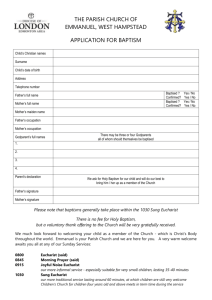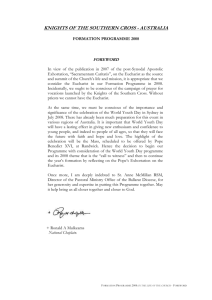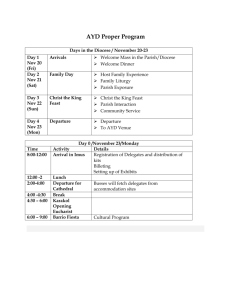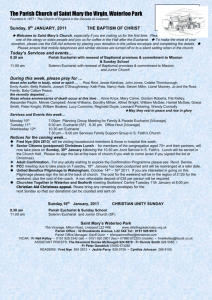Kindergarten Unit K.4 - Belonging to God's People
advertisement
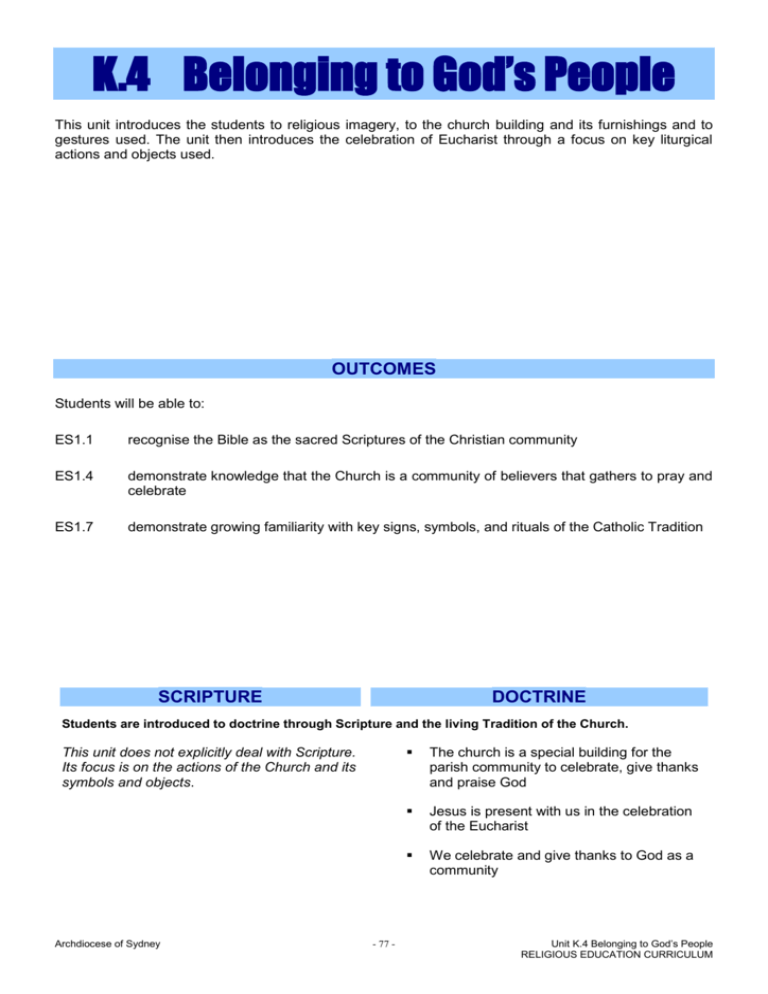
K.4 Belonging to God’s People This unit introduces the students to religious imagery, to the church building and its furnishings and to gestures used. The unit then introduces the celebration of Eucharist through a focus on key liturgical actions and objects used. OUTCOMES Students will be able to: ES1.1 recognise the Bible as the sacred Scriptures of the Christian community ES1.4 demonstrate knowledge that the Church is a community of believers that gathers to pray and celebrate ES1.7 demonstrate growing familiarity with key signs, symbols, and rituals of the Catholic Tradition SCRIPTURE DOCTRINE Students are introduced to doctrine through Scripture and the living Tradition of the Church. This unit does not explicitly deal with Scripture. Its focus is on the actions of the Church and its symbols and objects. Archdiocese of Sydney - 77 - The church is a special building for the parish community to celebrate, give thanks and praise God Jesus is present with us in the celebration of the Eucharist We celebrate and give thanks to God as a community Unit K.4 Belonging to God’s People RELIGIOUS EDUCATION CURRICULUM SPIRITUAL REFLECTION FOR TEACHERS In the first centuries of the Church, Christians gathered in homes to ‘break bread’. In time, a special “house-church” became the place for gathering. In the fourth century, when the communities had become larger, the Christians began to use ‘basilicas’, the public assembly halls of the time. There the Christians had ample space to gather, to hear the Word of God proclaimed and to celebrate the Eucharist. During the Middle Ages, there was a major shift: the altar was moved toward one end and eventually against the wall. The ‘sanctuary’ became the place where all liturgical ministry took place. The people remained in the nave, but they no longer participated as they had. They had become separated from the liturgical action. This arrangement remained into the early twentieth century. The Second Vatican Council, called for a re-ordering of this arrangement. The community is called to “full, active, and conscious participation” in the liturgy. When we use the word ‘Church’ we mean the People of God, all who are baptised. A church building then is a “house for the Church,” the place where the holy People of God do holy things. The liturgical celebrations of our faith community are religious and human experiences which engage the whole person. We see, hear and experience the liturgical signs, words and gestures. In what church or chapel have you experienced awe, wonder, reverence and the presence of God? CATECHISM OF THE CATHOLIC CHURCH Excerpts from the Catechism of the Catholic Church are included below as information for teachers. They present the Church’s teachings contained in the unit. 1179 The worship "in Spirit and in truth" of the New Covenant is not tied exclusively to any one place. The whole earth is sacred and entrusted to the children of men. What matters above all is that, when the faithful assemble in the same place, they are the "living stones," gathered to be "built into a spiritual house." For the Body of the risen Christ is the spiritual temple from which the source of living water springs forth: incorporated into Christ by the Holy Spirit, "we are the temple of the living God." 1181 A church, "a house of prayer in which the Eucharist is celebrated and reserved, where the faithful assemble, and where is worshipped the presence of the Son of God our Savior, offered for us on the sacrificial altar for the help and consolation of the faithful - this house ought to be in good taste and a worthy place for prayer and sacred ceremonial." In this "house of God" the truth and the harmony of the signs that make it up should show Christ to be present and active in this place. 2177 The Sunday celebration of the Lord's Day and his Eucharist is at the heart of the Church's life. "Sunday is the day on which the paschal mystery is celebrated in light of the apostolic tradition and is to be observed as the foremost holy day of obligation in the universal Church." 2179 "A parish is a definite community of the Christian faithful established on a stable basis within a particular church; the pastoral care of the parish is entrusted to a pastor as its own shepherd under the authority of the diocesan bishop." It is the place where all the faithful can be gathered together for the Sunday celebration of the Eucharist. The parish initiates the Christian people into the ordinary expression of the liturgical life: it gathers them together in this celebration; it teaches Christ's saving doctrine; it practises the charity of the Lord in good works and brotherly love: You cannot pray at home as at church, where there is a great multitude, where exclamations are cried out to God as from one great heart, and where there is something more: the union of minds, the accord of souls, the bond of charity, the prayers of the priests. Archdiocese of Sydney - 78 - Unit K.4 Belonging to God’s People RELIGIOUS EDUCATION CURRICULUM SCRIPTURE: BACKGROUND INFORMATION There is no specific Scripture text in this unit. However, as a strategy for recognising the Bible as the sacred texts of the Church it is suggested that different passages and verses are used for class prayer. Passages could be selected from other Kindergarten units, KWL book or from favourite biblical texts. SUGGESTED ASSESSMENT Suggestions for determining students’ development towards the achievement of the outcomes are included below: ES1.1 recognise the Bible as the sacred Scriptures of the Christian community The students typically might: ES1.4 describe how the Bible is used during the celebration of Eucharist explain why we place the Bible on the prayer space illustrate the lectern or lectionary make statements about why the Bible is sacred, eg we read stories about Jesus …there are stories about God… demonstrate reverence for the Bible in the classroom or church demonstrate knowledge that the Church is a community of believers that gathers to pray and celebrate The students typically might: ES1.7 identify Sunday as the day Catholics gather for worship and prayer talk about ways Catholics pray and worship demonstrate growing familiarity with key signs, symbols, and rituals of the Catholic Tradition The students typically might: make statements about or illustrate: altar, lectern, tabernacle, baptismal font, … describe one or two ritual actions in the Mass, eg we genuflect in the Church … the priest holds his hands over the bread and wine … we listen to the Bible … we bless ourselves… participate appropriately in ritual action know how to make the Sign of the Cross with some prompting, know when to bow or genuflect in the church bow or genuflect appropriately in the church Archdiocese of Sydney - 79 - Unit K.4 Belonging to God’s People RELIGIOUS EDUCATION CURRICULUM RESOURCES To Know Worship and Love – Prep/Kindergarten, Chapters 10 and 11, (2005), James Goold House Publications, Melbourne, Victoria Teacher Resources The Sacramentary – This is used for referring to the parts of the Mass. Also important is the section in the Roman Missal on the environment – Chapter 5 “Arrangement and Furnishings of the Church for the Eucharistic Celebration.” The Lectionary The Children’s Lectionary Audio-Visual Sydney Catholic Education Office, (2004), Things we see in Church, CD-ROM, Catholic Education Office, Leichhardt, Sydney NOTE: See RE Online for additional resources for this unit. Archdiocese of Sydney - 80 - Unit K.4 Belonging to God’s People RELIGIOUS EDUCATION CURRICULUM UNIT CONTENT A: WE VISIT THE CHURCH The Church has a special place for worship. Students will: explore the parish church and key objects in it: altar, lectern, tabernacle, presider’s chair, baptismal font, cross, paschal candle become familiar with gestures used in the church: genuflection, bowing, Sign of the Cross, … identify key people in the school and parish community: priest, parish associate, principal and other leaders BACKGROUND INFORMATION This Unit Content could be taught together with the HSIE unit ‘School Days’. It adds the religious dimension to the content in HSIE. As the children become familiar with people and places in the school they can also focus on: the parish church and objects around the school that indicate the Catholic identity of the school, eg crosses and religious art in classrooms and office area, prayer and sacred spaces … people who help nurture the religious and faith development of the community (school and parish): priest, parish associate, principal, teacher, parents … This Unit Content does not have a ‘story’ as such. However, it does tell the ‘story’ of the different religious objects in the church and school. That is, it is an opportunity to introduce or extend the children’s familiarity with these religious objects and their function in the Church. The explanation can take on a story approach. It is also an opportunity to introduce or review how we show reverence in the church. The teacher can model genuflecting and bowing at the appropriate times. We genuflect to show reverence to the reservation of the Blessed Sacrament, Jesus, in the tabernacle. We bow to the altar, to show reverence for the place at which we celebrate the Eucharist. Children learn these gestures by seeing others use them and by using the gestures themselves. Be sure to model for the children the practice of the local parish community. You may need to speak to the priest or principal about local practice. In all churches there are standard furnishings. Children may have experienced these in use. While we use the correct names with the children, it is not necessary for the children to know the correct names of all furnishings. It is enough for children to recognise them. What are the furnishings of the church? Sanctuary – This is the area around the altar. It is slightly higher than the body of the church. Altar – The table at which we celebrate the Eucharist. Lectern – This is the stand at which the Word is proclaimed. On it is placed the lectionary, the book of readings from the Bible, used in the liturgy. The lectern is also known as the ambo. Tabernacle – The Eucharist is kept in reserve here. There is usually a red light close to the tabernacle, indicating the presence of Jesus in the Eucharist. Presider’s Chair – This is the chair the priest uses during the celebration of the Mass. Baptismal font – This could be an opportunity to comment on baptism and the symbol of water. Notice where the font is situated. Paschal candle – The candle is blessed and lit for the first time at the Easter Vigil. It remains on the sanctuary. It symbolises Jesus, the light. In addition to the religious objects, this Unit Content also focuses on leaders and roles within the local Church. This is an opportunity to introduce children to key people in the parish and school community who have a role in the religious life and development of the community: the parish priest, the parish associates, the principal, the assistant principal and religious education coordinator. Archdiocese of Sydney - 81 - Unit K.4 Belonging to God’s People RELIGIOUS EDUCATION CURRICULUM SUGGESTED TEACHING/LEARNING STRATEGIES The following suggested activities are organised around the key elements of Telling the Story, Wondering, Exploring and Prayer. Teachers select, adapt or substitute activities, ensuring that each of the abovementioned elements is evident in the cycle of learning. NOTE: The structure and duration of this Unit Content will depend on accessibility to the parish church. Try to alternate visits to the church with ‘exploring’ activities. Also have a selection of objects in the classroom for children to engage with, eg Bible on the sacred space, crucifix and cross, pictures or models of a baptismal font, lectern, altar etc. Draw children’s attention to the Catholic identity of the school by referring to the name, eg “What’s the name of our school? Why do you think our school is called St Francis Xavier?” Children tour the classroom and school. Ask the children to look around and identify anything that may tell them it is a Catholic school. Some answers might be: crucifix, Bible, any statues or religious art, any posters of religious agencies … Explain what these are and why they are in the school. What does each object mean? How is it related to religion and of what does it remind us? Wonder with the children, eg: I wonder … - what the cross means - where else we see crosses - why we have the Bible in our school sacred space - what ____ means Children write or draw in their journals about their walk and what they noticed. While walking around the school, introduce children to people who help in their religious development: The principal and assistant principal and religious education coordinator as well as the parish priest and associate. Alternatively, invite these key people into the classroom to meet the children. Follow up: You might take a photo of these people and as a class write a profile of each person – name, position, sentence about what they do. Home activities: 1) Children look around their home and draw objects that show a Catholic or Christian identity. 2) Do the activity in KWL p71. Explore the concept of reverence through drama. Read KWL ch 10 as a preparation for visiting the church. Tour of the church. This could be done in 2 or 3 visits. Do not spend too long in the church. You might take the children on a quick overview tour of the church for the first visit and then go back on other occasions to look at focal points in greater depth: altar, tabernacle, lectern and lectionary, and baptismal font. You might take photos of the objects noticed, to remind children of the tour and use in responding activities. (Note: if it is impractical for your class to visit the church, taking photos yourself or finding good photos/illustrations could help the children think about various objects). Archdiocese of Sydney - 82 - Unit K.4 Belonging to God’s People RELIGIOUS EDUCATION CURRICULUM o Wonder with the children: I wonder … - why people come to the church - how we can be reverent in the church - why it is important to be ‘reverent’ in the church. Note: You will need to introduce the term ‘reverent’ or ‘reverence’ or use another word. o Students share their experiences of the church. Have you been in a church before? Why? If children do not attend Mass they may have experienced a Baptism or wedding. o Talk about appropriate ways of behaving in the church. How and why do we show reverence or respect? Why are we encouraged to be quiet and calm? Model for the children how we genuflect and bow – explaining when and why we do this. Allow children time to practice these gestures and use them in appropriate contexts. o Move around the church. Ask the children what they see/notice. Draw children’s attention to various objects and places. Discuss with the children the purpose of the items and how, when and why they are used. Why are they important? Tell the ‘story’ of the items. Focus on: the altar and the tabernacle, the lectern and lectionary, the presider’s chair, the crucifix, the paschal candle, the baptismal font. o Focus on the altar and tabernacle. Model for the children how to reverence the altar (bowing) and tabernacle (genuflecting). Explain what the altar is used for and why the light near the tabernacle is on. Begin with “I wonder what is in the tabernacle.” o When looking at the lectern, show students the lectionary and explain that these are readings from the Bible used in the liturgy. Model for the children how to reverence the Word of God. Light a candle and pray using Scripture or celebrate a simple liturgy of the Word: Sign of the Cross, a moment of silence, proclaim the Word, respond to the Word with a simple prayer and make the Sign of the Cross. Scripture from another unit already taught could be used. o When looking at the baptismal font, allow children to touch the water, splash the water yourself. Explain what the baptismal font is used for. Ask the children to bless themselves with water. Celebrate a blessing rite. You might invite the priest to celebrate a sprinkling rite with the class. Allow the children to draw what they found most significant. Some might draw the sprinkling of water, others might draw the tabernacle. Help them write a sentence about their drawing. Children could draw using ‘Paint’ or ‘Kids Pix” on the computer. Look at photos of different objects and label them with the class. Display children’s artwork with the photos. Children use play dough or clay to make 3D models of the church or any aspect of the church they found significant, eg the font, the paschal candle, the lectionary … Ask the priest to bless water with the students present. Keep this water in a bowl in the sacred space. Students could use this water to bless themselves during class prayer. This models the practice of blessing oneself when we enter the church and also draws the connection to Baptism. Archdiocese of Sydney - 83 - Unit K.4 Belonging to God’s People RELIGIOUS EDUCATION CURRICULUM UNIT CONTENT B: WE GATHER FOR MASS On Sunday the Church gathers to celebrate the Eucharist. Students will: explore some liturgical objects used in the celebration of the Eucharist: chalice, paten, vestments, lectionary recognise some rituals in the Eucharist BACKGROUND INFORMATION After focusing on the church, its furnishings and significant people, the children are introduced to what happens in the church: the celebration of the Eucharist. As with Unit Content A it is also an appropriate time to give children experiences that develop skills in prayer – silence, stillness, Sign of the Cross, ways of showing reverence during prayer. Unit Contents A and B could be taught in any order, or integrated into one sequence. Children are given the opportunity to look at liturgical objects. Lectionary – The book from which we read the Word of God. It is the collection of Scripture readings, used in the liturgy. The readings are organised according to the liturgical year. Chalice – The cup that holds the wine that is consecrated. Paten – The plate that holds the bread, or hosts, to be consecrated. Vestments – The clothing of the presider (priest). Children do not need to know these by name. This Unit Content lays foundations for learning about the celebration of the Eucharist in later years. Children will come to Kindergarten with various levels of participation in the life of the Church and therefore various levels of familiarity with the Mass. In looking at the rituals of the Eucharist begin with actions and words that the children recall. Explore these and expand children’s knowledge. For example, a child might recall an experience of shaking hands at Mass. Talk about this, explain this is the ‘Sign of Peace’, we shake hands to wish each other the peace of Jesus. All practise giving the ‘Sign of Peace’. You might focus on actions, words they recall, times of silence, singing etc. At this foundational stage draw children’s attention to the two highpoints of the Eucharist: 1. We listen to the Word of God – explore listening. 2. We celebrate the Eucharist – focus on the bread and wine. We remember what Jesus did at the Last Supper. Children do not need to know the structure of the liturgy or main components. For Kindergarten, it is sufficient that children recognise some rituals, actions and words, used in the Eucharist. Children’s understanding of the Sacrament of Eucharist will be developed further in later years. In teaching this Unit Content it might be appropriate for the class to participate in a Mass. This might be a school Mass or a parish Mass. Alternatively you might invite the priest to celebrate a Liturgy of the Word or Penitential Rite or Rite of Blessing with the class. Archdiocese of Sydney - 84 - Unit K.4 Belonging to God’s People RELIGIOUS EDUCATION CURRICULUM SUGGESTED TEACHING/LEARNING STRATEGIES The following suggested activities are organised around the key elements of Telling the Story, Wondering, Exploring and Prayer. Teachers select, adapt or substitute activities, ensuring that each of the abovementioned elements is evident in the cycle of learning. Invite the parish priest, to show and explain to children the use of different liturgical items used in the celebration of Mass: coloured vestments, chalice, paten, lectionary … Set up a table in the classroom with models of objects used at Mass: chalice, paten, candle, and Bible. You can use a plastic wine cup and a small plate for the chalice and paten. The Bible can replace the Lectionary and Sacramentary Explain to the children that we use these things at Mass. We gather for Mass on Sunday. Identify Sunday on the calendar of the week. Children make a liturgical object of their choice out of clay or play dough. Incorporate the prayer in KWL p79 into morning and afternoon prayer. You might then bless the children before they go home in the afternoon; or in the morning pray for a blessing on the day ahead. You could also use parts of the greeting or dismissal rites for prayer with the children. Read KWL ch 11. Wonder with the children using ‘I wonder’, KWL p78. - why we gather at the church on Sundays - why we celebrate Mass. Children share their knowledge of the Mass. What words or actions do you remember from the Mass? Role-play these and teacher writes the name, eg “we shake hands”. Teacher explains this is the ‘Sign of Peace’. All practice giving the ‘Sign of Peace’. Create a list of these actions and words. Children draw one part of the Mass. Show children pictures / photos of different parts of the Mass. Explain what is happening. Home activities: 1) Parents and students say a prayer before bedtime. Parents might conclude by blessing their children. 2) Children share one or two gestures from the Mass with their parents. 3) Do the activity in KWL p79. Read KWL ch 11 with parents. Liturgy of the Word Take the children to the church and show them the lectionary, lectern and the altar. Or remind them of these from previous visits. Show children the Bible. Explain how we listen to the Word of God at Mass. What stories do you know from the Bible? Explain how we reverence the Bible. Why do we take special care of the Bible? How can we take special care of the Bible in our classroom? Wonder with the children: - when we listen to God’s Word at Mass - why we listen to God’s Word at Mass. Children journal their responses to the wondering, with the help of an adult. Archdiocese of Sydney - 85 - Unit K.4 Belonging to God’s People RELIGIOUS EDUCATION CURRICULUM Celebrate a short Liturgy of the Word. 1. Begin with a song and a procession of the Word to emphasise reverence. 2. Choose an appropriate Gospel passage – a few verses from Scripture already used in the Kindergarten curriculum. 3. Use the formula from the Mass: a. “A reading from the holy Gospel according to ____” b. All respond “Glory to you, Lord” with the appropriate action – cross on the forehead, lips and heart. c. After reading the Gospel say, “This is the Gospel of the Lord.” d. All respond “Praise to you, Lord Jesus Christ.” Liturgy of the Eucharist Recall the altar and the tabernacle. “What happens on the altar?” Then seat the children in a circle and tell the story of the Eucharistic Prayer. See KWL p76 and ‘Resource Sheet 1’ for a script. Wonder with the children: - why we share Jesus in the bread and wine - how Jesus feeds his sheep - how we can help feed those who are hungry. Children illustrate a part of the story they remember. Use paints or crayons. Use gestures and words from the Mass in class prayer. For example: children exchange the Sign of Peace, greetings, dismissal, Our Father, bow to the Bible before reading from it, make the Sign of the Cross, Prayers of the Faithful – “Lord, hear us… Lord, hear our prayer”, Penitential Rite. Archdiocese of Sydney - 86 - Unit K.4 Belonging to God’s People RELIGIOUS EDUCATION CURRICULUM Resource Sheet 1 SCRIPT for Unit Content B The Blessing of Bread and Wine (extracts from the Eucharistic Prayer) YOU WILL NEED: cloth (colour of the season) Bible some bread on a plate (paten) grape juice in a ‘chalice’ Children are seated in a semi-circle ready to listen to the story. When the children are settled, go to the shelf and carry the materials as you would the Bible. Place these beside you. Lay seasonal cloth down. Place Bible, bread and juice on the cloth. When the community celebrates Mass we come together as the community of God. Hold or touch the Bible. We listen to the Word of God from the Bible. Then we take the bread and wine to the altar. During Mass we remember what Jesus did during the Last Supper. Hold bread in your hands, showing the children. The priest takes the bread, blesses it and says the words Jesus used: ‘Take this, all of you, and eat it. This is my body.’ Put the bread back on the cloth and take the cup of grape juice. He then takes the wine and blesses it saying Jesus’ words again, ‘Take this all of you and drink from it: This is the cup of my blood.’ Put the cup of wine back on the cloth. The priest then gives the people the bread, which is Jesus, to share. This is Holy Communion. Engage with ‘I wonder’, KWL p78. Carefully pack story materials into storage box and put on shelf. Ensure that children are watching so they know how to pack the materials away and where to find them. Be sure to make it clear that this is not the Eucharist/Mass. The class is recalling what happens in Mass. Archdiocese of Sydney - 87 - Unit K.4 Belonging to God’s People RELIGIOUS EDUCATION CURRICULUM Archdiocese of Sydney - 88 - Unit K.4 Belonging to God’s People RELIGIOUS EDUCATION CURRICULUM
